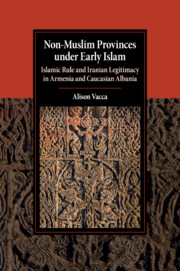 Non-Muslim Provinces under Early Islam
Non-Muslim Provinces under Early Islam Book contents
- Frontmatter
- Dedication
- Contents
- List of Illustrations
- Acknowledgments
- Situating Places, People, and Dates
- 1 Non-Persian Provinces of Iran, Non-Muslim Provinces of Islam: An Introduction to the Umayyad and ʿAbbāsid North
- 2 Whence the Umayyad North?: Byzantine, Sasanian, and Caliphal Administrative Geography of the North
- 3 Lost Greek Kings and Hoodwinked Khazars: Sasanian and Byzantine Legacy in the Construction of Caliphal Frontiers in the North
- 4 The So-Called Marzb ā ns and the Northern Freemen: Local Leadership in the North from Sasanian to Caliphal Rule
- 5 Caliphs, Commanders, and Catholicoi: Mechanisms to Control the North under Byzantine, Sasanian, and Caliphal Rule
- 6 Taxing the Dead and Sealing the Necks of the Living: Sasanian and Caliphal Treaties and Taxation in the North
- 7 Collective Historical Amnesia: The Case for a Parthian Intermezzo
- Bibliography
- Index
- Miscellaneous Endmatter
3 - Lost Greek Kings and Hoodwinked Khazars: Sasanian and Byzantine Legacy in the Construction of Caliphal Frontiers in the North
Published online by Cambridge University Press: 08 September 2017
- Frontmatter
- Dedication
- Contents
- List of Illustrations
- Acknowledgments
- Situating Places, People, and Dates
- 1 Non-Persian Provinces of Iran, Non-Muslim Provinces of Islam: An Introduction to the Umayyad and ʿAbbāsid North
- 2 Whence the Umayyad North?: Byzantine, Sasanian, and Caliphal Administrative Geography of the North
- 3 Lost Greek Kings and Hoodwinked Khazars: Sasanian and Byzantine Legacy in the Construction of Caliphal Frontiers in the North
- 4 The So-Called Marzb ā ns and the Northern Freemen: Local Leadership in the North from Sasanian to Caliphal Rule
- 5 Caliphs, Commanders, and Catholicoi: Mechanisms to Control the North under Byzantine, Sasanian, and Caliphal Rule
- 6 Taxing the Dead and Sealing the Necks of the Living: Sasanian and Caliphal Treaties and Taxation in the North
- 7 Collective Historical Amnesia: The Case for a Parthian Intermezzo
- Bibliography
- Index
- Miscellaneous Endmatter
Summary
In the tenth century, a vizier named Abū Dulaf regaled the Būyid court with tales of his youthful trips to distant lands. In his stories, if maybe not in real life, he traveled to China, Central Asia, and India. He also claims to have visited the North, an assertion backed up by a close study of the details of his travel memoires. Abū Dulaf describes Tiflīs/Tp'ilisi as “a town beyond which there is no Islam.” With this comment, the traveler and littérateur made an explicit distinction between Islamic and non-Islamic lands and, further, the exact location where one is distinguished from the other. The North was important to ʿAbbāsid-era historians and geographers because it delineated the Caliphate from other major powers: Byzantium to the west and the Turkic and Khazar tribes to the north. This demonstrates a conceptual divide between the Caliphate and its neighbors that was written into ʿAbbāsid-era cosmography.
Armenia and Albania were the bulwark against the enemies of the Caliphate. This frontier, though, is mainly a literary construction, designed to paint strict divisions between the polities by locating it as a destination of mujāhids and as an impenetrable line of fortresses. In this effort, it was important to stress the inclusion of the North as caliphal territory. As the anonymous tenth-century Borders of the World claims, these provinces were, in fact, “the most pleasant places in dār-i islām.” Because of this agenda, the idea of a buffer zone “entre Byzance et l'Islam” sits uncomfortably with the description of the frontiers (thughūr) in Arabic geographical texts. The frontiers maintain their significance because of their conceptual role, built at least in part by the reinterpretation of the regions' Byzantine and Sasanian past. The manipulation of historical traditions about Byzantine and Sasanian presence in the North reveals that the regions' Iranian identity was pivotal in the construction of the frontier.
Here we look first at the descriptions of borders (ḥudūd) and frontiers (thughūr) in the late ninth- and tenth-century Arabic accounts and we problematize the reliance on buffer zones and “protectresses” (ʿawāṣim). We also review the foundation narratives of Qālīqalā/Karin and Bāb al-Abwāb/Darband as case studies of how the authors of these same geographies and histories constructed the conceptual frontier in reference to the regions’ Iranian identity. The Iranian character of the frontier, as depicted in Arabic sources, makes a comparative approach with other caliphal frontiers particularly productive.
- Type
- Chapter
- Information
- Non-Muslim Provinces under Early IslamIslamic Rule and Iranian Legitimacy in Armenia and Caucasian Albania, pp. 78 - 111Publisher: Cambridge University PressPrint publication year: 2017


